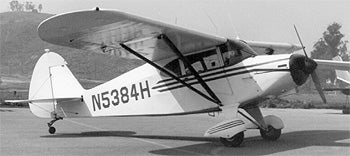PIPER PA-15/PA-17 “VAGABOND”/PA-16 “CLIPPER”
1948’49
 |
| STANDARD DATA: (PA-15) Seats 2. Gross wt. 1,100. Empty wt. 620. Fuel capacity 36. Engine 65-hp, Continental. PERFORMANCE: Top mph 100. Cruise mph 90. Stall mph 45. Initial climb rate 510. Range 250. Ceiling 10,000. Takeoff run 900. Landing roll 300.STANDARD DATA: (PA-16) Seats 4. Gross wt. 1,500. Empty wt. 800. Fuel capacity 36. Engine 115-hp Lycoming. PERFORMANCE: Top mph 125. Cruise mph 112. Stall mph 50. Initial climb rate 600. Range 480. Ceiling 11,000. Takeoff run 720. Landing roll 600. STANDARD DATA: (PA-17) Top mph 100. Cruise mph 90. Stall mph 45. Initial climb rate 530. Ceiling 10,500. Range 250. Takeoff run 800. Landing roll 300. |
The PA-15 entered production in 1948 and was one of the first to appear after Piper had temporarily suspended its activities. Originally powered by a 65-hp Lycoming engine, the PA-15 Vagabond was a side-byside two-seater and a forerunner of a new series that would come to include the Clipper, Pacer, and ultimately the Tri-Pacer. The PA-17, introduced in 1949, was primarily intended to serve as a trainer and with a 65-hp, Continental installed. The PA-15 and PA-17 were not built in large quantities, perhaps due to the fourseat PA-16 Clipper, which was also produced in 1949. The PA-16 housed a 115-hp Lycoming engine and subsequently evolved into the PA-20 Pacer.
ODEA DeveloperWriter
Related Stories

Subscribe to Our Newsletter
Get the latest Plane & Pilot Magazine stories delivered directly to your inbox





